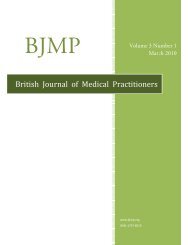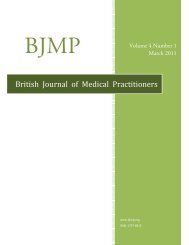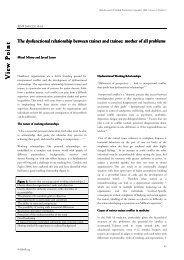R esearch A rticle - British Journal of Medical Practitioners
R esearch A rticle - British Journal of Medical Practitioners
R esearch A rticle - British Journal of Medical Practitioners
You also want an ePaper? Increase the reach of your titles
YUMPU automatically turns print PDFs into web optimized ePapers that Google loves.
<strong>British</strong> <strong>Journal</strong> <strong>of</strong> <strong>Medical</strong> <strong>Practitioners</strong>, March 2013, Volume 6, Number 1<br />
distinguish from low mood and daytime sleepiness, both <strong>of</strong><br />
which are common to depression.<br />
A four-year prospective longitudinal study <strong>of</strong> 79 patients found<br />
that 13.9% <strong>of</strong> those with PD had persistent apathy and 49.4%<br />
had developed apathy at follow up. The study showed apathy to<br />
be a frequent and persistent behavioural feature in PD with a<br />
high incidence and prevalence over time, and associated with<br />
neurotransmitter deficits. 20<br />
Aetiology and risk factors<br />
The dorsolateral, medial and orbital frontal cortices, as well as<br />
subcortical structures such as the basal ganglia, thalamus and<br />
internal capsule are implicated in the pathogenesis <strong>of</strong> apathy.<br />
The independent risk factors for apathy are dementia at<br />
baseline, a more rapid decline in speech, and axial impairment<br />
(e.g. poor ability to turn in bed) during follow up. 20, 21 A more<br />
recent study showed that male gender, higher depressive scores,<br />
and severe motor symptoms, were significantly associated with<br />
apathy, but not with greater cognitive impairment. 22 It has been<br />
observed that deep brain stimulation (DBS) may contribute to<br />
the development <strong>of</strong> apathy 23 but other studies show conflicting<br />
results. 24<br />
Presentation and diagnosis<br />
There is a higher incidence <strong>of</strong> depression and dementia in PD<br />
patients with apathy. Therefore differential diagnosis between<br />
apathy and cognitive deficits and depression is essential because<br />
the therapeutic approaches are different. 19, 20 It is equally<br />
important to differentiate between apathy and depression that<br />
are different clinical entities although both may coexist. The<br />
crucial difference is that people with apathy lack serious selfreproach<br />
or feelings <strong>of</strong> guilt. 21, 25 The Lille Apathy Rating Scale<br />
(LARS), administered as a structured interview, can be a useful<br />
tool to distinguish them both 26 though further r<strong>esearch</strong> is<br />
needed to differentiate the neurological and neurochemical basis<br />
for depression and apathy.<br />
Treatment<br />
Treatment options for apathy are limited. The use <strong>of</strong><br />
methylphenidate, a stimulant drug related to amphetamine, has<br />
been suggested but evidence is scarce and side effects may<br />
outweigh its clinical benefit. 27 Methylphenidate has been<br />
described as effective for both apathy and fatigue 28 but more<br />
studies are necessary. Antidepressants are not effective, can<br />
cause unnecessary side effects and can even aggravate apathy,<br />
demonstrating that these syndromes are really<br />
independent. 29 The association between cognition and apathy,<br />
along with the potential benefit <strong>of</strong> cholinesterase inhibitors on<br />
both cognition and apathy, suggests that cholinergic<br />
mechanisms take part in the pathophysiology <strong>of</strong> apathy. 30,<br />
31<br />
’Off-time’ refers to periods <strong>of</strong> the day when the medication is<br />
not working well, causing worsening symptoms <strong>of</strong> fatigue and<br />
apathy. ‘Wearing-<strong>of</strong>f’ episodes may occur predictably and<br />
gradually, or they may emerge suddenly and unexpectedly.<br />
Wearing-<strong>of</strong>f periods may be improved with appropriate changes<br />
in the medication regimen. This would mean optimizing<br />
dopaminergic agents or using a long-acting levodopa or a<br />
catechol-O-methyltransferase (COMT) inhibitor. Wearing <strong>of</strong>f<br />
may be also better controlled by shortening the time between<br />
medication doses. In a study <strong>of</strong> 23 PD patients in both the 'on'<br />
and '<strong>of</strong>f' states compared to 28 controls, L-dopa had a positive<br />
effect on motivation suggesting striat<strong>of</strong>rontal loops are<br />
involved. 32<br />
Involuntary emotional expression disorder<br />
Epidemiology<br />
Involuntary emotional expression disorder (IEED) has been<br />
found to occur in 16.8% <strong>of</strong> PD patients, and in 15.3% if<br />
comorbid depressive disorder was excluded. 33 However, other<br />
studies suggest that the symptoms <strong>of</strong> IEED are present in up<br />
15% <strong>of</strong> PD patients but the actual IEED disorder occurs in half<br />
<strong>of</strong> these cases. 34 This implies that IEED symptoms occur in PD<br />
but the condition <strong>of</strong> IEED is not present although this may<br />
depend on the criteria used for the diagnosis. If IEED does<br />
develop in PD it is particularly common in the later stages <strong>of</strong><br />
PD and is likely to be distinct from depressive disorder which<br />
33, 35<br />
remains an important differential diagnosis.<br />
Aetiology and risk factors<br />
IEED can occur in neurological conditions such as stroke,<br />
traumatic brain injury, amyotrophic lateral sclerosis, multiple<br />
sclerosis, seizure disorders, multiple system atrophy, corticobasal<br />
degeneration, and Alzheimer’s disease. 35 Injury to the<br />
neurological pathways that control the expression <strong>of</strong> emotion<br />
have been implicated in its pathogenesis. Emotional expression<br />
involves various pathways within the frontal lobe, limbic<br />
system, brainstem and cerebellum, with disruption <strong>of</strong> regulatory<br />
36, 37<br />
and inhibitory mechanisms in this network implicated.<br />
Presentation and diagnosis<br />
IEED is described as sudden episodes <strong>of</strong> laughing or crying that<br />
may be spontaneous or disproportionate to the triggering<br />
stimuli. The emotional outbursts <strong>of</strong> IEED may involve<br />
laughter, crying or anger. The episodes all share common<br />
features in that they are involuntary, uncontrollable, and<br />
excessive, not sustained, and usually last from seconds to<br />
minutes. Outbursts are <strong>of</strong>ten stereotyped though single<br />
individuals may have episodes <strong>of</strong> both laughing and crying.<br />
IEED is also known as pseudobulbar affect, pathological<br />
laughter and crying, emotional lability, emotionalism, and<br />
emotional dysregulation. Despite the various terms used to<br />
describe the disorder, IEED is <strong>of</strong>ten missed and even sometimes<br />
mistaken for depression. 33, 35 Symptoms <strong>of</strong> IEED are important<br />
because they are associated with an impairment <strong>of</strong> social and<br />
occupational functioning. 38 It is hypothesized that neurological<br />
disease and injuries affect the excitatory action <strong>of</strong> glutamate,<br />
BJMP.org<br />
25







